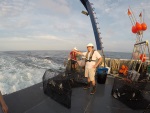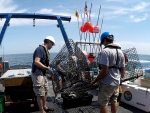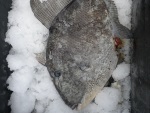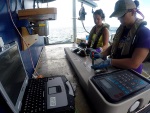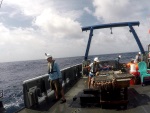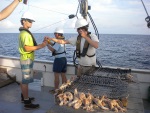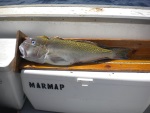Reef Fish Survey (RFS)
Marine Resources Monitoring, Assessment, and Prediction (MARMAP) &
Southeast Area Monitoring and Assessment Program South Atlantic (SEAMAP-SA)
Field Sampling
Fishery-independent sampling means that data are collected based on a scientific design rather than "fishing". This means that we are able to sample all fish even when management regulations prevent commercial and recreational fishers from harvesting certain fish. Since we adhere to a standard and strong scientific design, our information about fish is unbiased by things like targeting specific fish or technology advancements like better sonar and provides more robust data than might be available from heavily fished or heavily managed fish. The RFS samples live bottom (low-relief rocky outcrops with sponge, soft coral, and algal growth), high-relief ledges, and deepwater non-reef habitat with soft-sediments in the Atlantic Ocean off the southeastern United States to obtain fishery independent data on the continental shelf, shelf edge, and continental slope. The RFS began establishing fishery-independent monitoring stations with known habitat for reef fish and tilefish in 1981 and continues to establish sampling stations in newly documented habitat. The primary gears used by the RFS for fishery-independent monitoring of reef fish and tilefish are the chevron trap, short-bottom longline, and long-bottom longline. The RFS also uses hook and line and underwater video.
The RFS deploys more than 500 chevron traps each year. Chevron traps are arrowhead-shaped traps constructed of 35 mm x 35 mm square mesh plastic-coated wire with one tear-drop shaped funnel opening. Chevron traps are deployed from depths of 60 feet up to 300 feet. Traps are baited with Menhaden and deployed for about 90 minutes over live bottom with low relief. Chevron trap surveys are conducted primarily on board the RV Palmetto. All fish captured in chevron traps are identified, weighed, and measured using an electronic fish measuring board. Priority species in the South Atlantic Fishery Management Council's Snapper-Grouper complex are kept for age, reproduction, and diet studies.
Short-bottom longlines are used to sample high relief habitat in deeper waters (300 – 1,000 feet). Circle hooks are attached to 20 gangions along 26 m of ground line and baited with squid. Common species collected with the short-bottom longline include various groupers and tilefish. Long-bottom longlines are used to sample low relief, soft-sediment bottom inhabited by tilefish. These habitats typically are deep (~ 600 feet). 100 gangions with circle hooks baited with squid are attached to approximately 1200 m of ground line.

